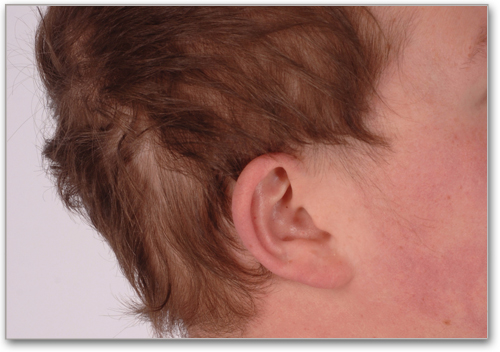Screening Scalp/Body Hair for Chronic GVHD
Below are clinical manifestations in a patient's scalp and body hair that are potential early indicators of chronic GVHD. If GVHD is suspected, timely collaboration with the patient's transplant center is recommended to confirm the diagnosis and to develop and evaluate a treatment plan.
These guidelines are based on published diagnostic criteria from the National Institutes of Health (NIH) Consensus Development Project on chronic GVHD. [1,2,3]
Clinical Examination
- Visual inspection of scalp hair/body hair for changes in hair distribution, consistency, and color
Diagnostic Testing
- None
Patient-Reported Symptoms and Signs
- Premature gray or thinning hair
- Itchy scalp
- Hair loss
Possible Manifestations
New Onset of Scarring or Non-Scarring Scalp Alopecia*

After initial recovery following chemotherapy or radiotherapy
Loss of body hair*
Scaling*
An eruption composed of papules and scales
Thinning Scalp Hair**
Typically patchy, coarse or dull (not explained by endocrine or other causes)
Premature Gray Hair**
Notes
* Distinctive but insufficient alone to establish an unequivocal diagnosis of chronic GVHD without further testing or additional organ involvement
** Rare, controversial, or non-specific features of chronic GVHD.
*** Common in both acute and chronic GVHD
References
- Jagasia MH, Greinix HT, Arora M, et al. National Institutes of Health Consensus Development Project on Criteria for Clinical Trials in Chronic Graft-versus-Host Disease: I. The 2014 Response Criteria Working Group Report. Biol Blood Marrow Transplant. 2015; 21(3): 389-401.
- Lee SJ, Wolff D, Kitko C, et al. Measuring therapeutic response in chronic graft-versus-host disease. National Institutes of Health Consensus Development Project on Criteria for Clinical Trials in Chronic Graft-versus-Host Disease: IV. The 2014 Response Criteria Working Group Report. Biol Blood Marrow Transplant. 2015; 21(6): 984-999.
- These guidelines have been developed by the National Marrow Donor Program® (NMDP)/Be The Match® in consultation with Sandra A. Mitchell, CRNP, MScN, AOCN; National Institutes of Health Clinical Center; and Steven Z. Pavletic, M.D.; National Cancer Institute, National Institutes of Health, Bethesda, Md. The information in this document does not represent the official position of the NIH or the U.S. Government.
Additional review from:
- Dennis L. Confer, M.D., NMDP/Be The Match, Minneapolis, Minn.
- Linda J. Burns, M.D., NMDP/Be The Match, Minneapolis, Minn.
- Madan Jagasia, M.D., Vanderbilt University Medical Center, Nashville, Tenn.
- Stephanie J. Lee, M.D., Fred Hutchinson Cancer Research Center, Seattle, Wash.
Text adapted from reports of the NIH Consensus Development Project on Criteria for Clinical Trials in Chronic Graft-versus-Host Disease from Biology of Blood and Marrow Transplantation by American Society for Blood and Marrow Transplantation. Reproduced with permission of Elsevier, Inc.
Photo Credits
- Photos/ Keratosis Pilaris; Lichen Planus-like; Hypopigmentation; Sclerosis; Erosion; Maculopapular: Maria L. Turner, M.D.; Edward W.Cowen, M.D.; Dermatology Branch, National Cancer Institute, NIH, Bethesda, Md.
- Photos/ Poikiloderma; Morphea; Lichen Planus-like; Lichen Sclerosus-like; Hyperpigmentation; Sclerosis; Nail dystrophy; Alopecia; Edema: Edward W. Cowen, M.D.; Dermatology Branch, National Cancer Institute, NIH, Bethesda, Md.
- Photos/ Lichen planus; Mucoceles; Erythema: Mark M. Schubert, D.D.S., M.S.D.; Fred Hutchinson Cancer Research Center, Seattle, Wash.
- Photo/ Keratoconjunctivitis: Mary E.D. Flowers, M.D.; University of Washington, Seattle, Wash.
- Photo/ Blepharitis: Janine A. Smith, M.D.; National Eye Institute, NIH, Bethesda, Md.
All photos used with permission.